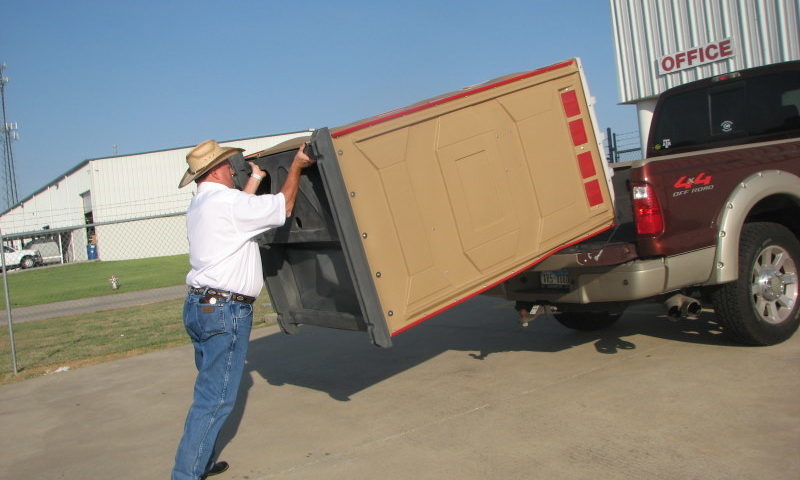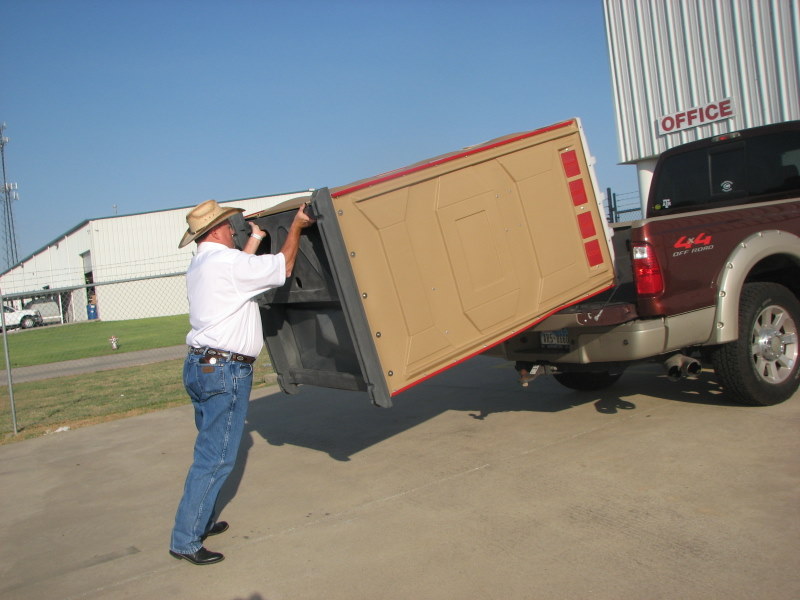
Pros & Cons of Digital Contracts
October 8, 2018
How to Boost Your Social Media Game
October 15, 2018Every day, portable restroom operators and their crews load, transport, and receive shipments. Your income comes from your portable toilets. Therefore, damaged equipment, regardless of the cause, halts your operations.
Finding damage upon delivery of your units is frustrating. However, it’s worse if the damage isn’t noticed until you’re preparing the unit for transport to a customer’s event. The same goes for equipment that arrives at the client’s site damaged. Both cost you money and waste time.
However, the price of repairs often pales in comparison to an injured employee. Unsafe methods of loading and unloading result in worker’s compensation claims.
Whether you’re dealing with damaged portable restroom units or a workplace injury, both problems may affect your customers. The bottom line is that improper techniques and lack of procedures decrease your profits. Reduce your company’s risk by inspecting deliveries and knowing how to properly load, ship, and unload toilets.
Why Newly Purchased Units Get Damaged During Transit
Depending on where your toilets are coming from, your new equipment may spend many miles out on the road. Due to traffic, weather conditions, or erratic driving, units may bump, slide, or fall while in transit. Some shipping companies also have higher claim rates from improper loading and unloading procedures.
Experts in the portable restroom industry call damaged units “problematic.” This ongoing issue is a massive source of frustration for portable restroom operators.
Your best bet is to talk to your portable restroom supplier about your transit options, have a delivery plan in place, and understand your responsibility and warranty. Many PROs prefer buying units from companies with local distribution or manufacturing facilities, as this cuts down on the time your new units spend in transit.
Read Your Contact Before Purchasing Toilets
Not all portable toilet manufacturers assume the responsibility of shipped units. In fact, contracts among suppliers may vary greatly. Speak with your customer service representative before ordering. Make sure you understand who is responsible once the equipment leaves the manufacturer’s shipping dock. Two types of contracts PROs encounter are:
- Free On Board Shipping Point (FOB). Both the seller and buyer sign this agreement. Liability stays with the seller until the truck carrying the unit leaves the seller’s yard.
- Destination Contracts. This agreement holds the seller responsible for the unit until it arrives at the buyer’s destination. If equipment comes damaged, then the liability falls on the seller.
Knowing what type of agreement you’re using is important, so you know whom to call if damage occurs during transit.
Understand Seller and Shipper Warranty and Return Policies
Before placing an order, you should be aware of the return procedures and what the company guarantees. Any employees that accept and inspect deliveries need to know this critical information.
While you, as the buyer, aren’t held responsible for items damaged during transit, you need to have contact information on hand for reporting a shipping loss. Depending on your agreement, you may need to contact the shipping company, not the seller, to get the item replaced.
Inspect goods before you accept a delivery.
PROs who adopt procedures for handling shipments and ensure that all employees follow these steps experience fewer issues with equipment returns and warranty disputes. A consistent process is crucial. If you don’t currently use a checklist or require workers to sign off on deliveries, then start by writing down the steps that you take with deliveries.
Walk each employee through your process. Allow them to handle a delivery on their own and give them feedback. A written process and proper training ensure that all staff can manage a delivery efficiently if you’re short-handed for a day. Operators use delivery procedures to ensure minimal disruption from the hassle of damaged goods.
Follow Inspection Procedures
The best way to avoid issues with shippers or sellers is to follow an inspection process. All new equipment should be given a thorough once-over before any paperwork is signed and prior to the driver leaving your property.
- Remove all straps, boxes, and packaging from the unit.
- Go over the unit from top to bottom looking for superficial damage.
- Look at every inch of the tank and check for cracks or chips.
- Check the plumbing and flushing mechanisms for holes or cracks.
- Inspect toilet for concealed damages.
- Verify all purchased parts and accessories are with your package.
Don’t dismiss the driver until you’ve thoroughly gone over each delivered item. While drivers don’t like waiting around, a satisfactory inspection is crucial. Failing to identify damage from transit results in more hassle afterward.
There’s Damage, Now What?
If you or your staff notice damage to a newly shipped unit, take immediate action. PolyJohn recommends that PROs:
- Inspect units before the delivery driver leaves.
- Show damage to the driver.
- Refuse all or part of the shipment.
- Note the problems on the bill of lading (shipping document). If operators don’t note visible damages on the freight bill, then your claim may be denied.
- Contact the customer service representative that shipped the package.
Double-check your documentation for information on who to call if a unit arrives broken. If your buyer is not responsible for damage during shipping, you’ll need to contact your carrier.
For operators who didn’t catch the damage until the delivery driver left the property, you’ll need to act quickly. If it’s the carrier’s responsibility, you must file a “concealed damage” claim. You can find this form on your carrier’s website.
The National Motor Freight Classification (NMFC) – Rule 300100 – requires that all concealed/non-notated damages must be reported within five business days of delivery (1st day is the day of delivery). Reporting after this time will void a claim.
Get the JohnTalk “ALL-ACCESS PASS” & become a member for FREE!
Benefits Include: Subscription to JohnTalk Digital & Print Newsletters • JohnTalk Vault In-Depth Content • Full Access to the JohnTalk Classifieds & Ask a PRO Forum
Protect Your Shipment
While the shipping aspect of your new portable toilets is out of the operator’s control, it’s necessary to take responsibility by thoroughly checking over every delivery.
With the age of technology, we’ve seen some PROs use mobile phones to their advantage. By taking a video or pictures of the locations and types of damage, operators can document every step of the process.
By following these steps and developing a delivery policy, you’ll be able to limit the risk to your business when receiving deliveries of portable restroom units.
Manage Your Loading and Unloading Process
Portable restroom operators send out units nearly every day. With this amount of on-the-road time, a big chunk of your money depends on your portable restrooms staying in top shape through hundreds of trips.
From safety to saving time, setting up procedures is imperative. Workers in a rush may skip steps in your process. Something small, like forgetting to remove or secure the paper products within the unit, results in product waste. More significant issues, such as over-strapping, cause considerable damage.
Go through your loading process with your drivers. While long-term employees may have the job down, it never hurts to provide a refresher course or double-check that your staff follows your recommendations.
Step-by-Step Loading from Your Lot or Customer Site
Following a loading procedure ensures that employees are efficient and safe. Make sure your drivers can walk you through the process without missing a step every single time.
- Make sure no one is inside.
- Pump the waste.
- Remove or secure toilet paper and close the door.
- Drop the tailgate on the truck.
- Slide a dolly under the skid from the rear of the unit.
- Put your foot on the axle of the dolly.
- Grab the rear corners of the unit a high up as you can, one hand for each corner.
- Pull the unit backward towards you, using your foot to keep the bottom from moving.
- Keep the unit balanced over the axle of the dolly.
- Dolly the unit to the loading zone of your truck.
- Push the unit right up to the lip of the tailgate, so the front of the skid is on top of your rack.
- Hold steady and push (with your legs, not back) the unit into the truck.
A handy trick for loading portable toilets is to turn the units so that the doors are facing the back of the truck. This keeps restrooms cleaner and helps prevent scratching during highway trips.
Encourage Safe Methods of Lifting
Workers get injured on the job in a variety of ways. One-time accidents, like a fall or shoulder strain, prevent employees from doing their job until they’re recovered. Repetitive damage stemming from improper posture while driving or overexertion results in musculoskeletal disorders (MSDs).
The U.S. Department of Labor ranks truck driving second for occupations with the most significant risk of MSDs. Furthermore, workers who drive and lift freight report higher lost work time due to injury.
Injuries occur from overexertion, falling, equipment hitting the employee, improper lifting, reaching or other unnatural positions, and improper gripping of the unit. Repetitive or inappropriate use of dollies and other support equipment also cause workplace injuries.
The National Institute for Occupational Safety and Health provides guidelines for jobs involving lifting or loading. OSHA suggests that workers:
- Minimize the distance between the load and the body.
- Lift loads from knuckle height.
- Keep the travel distance for the lift to less than 10 feet.
- Minimize twisting.
- Provide good handles for grasping.
A common problem in the portable sanitation industry is shoulder injuries followed by back problems. Portable restroom operators combat workplace accidents by cultivating a safe culture. Start by demonstrating and teaching safe techniques for lifting, climbing, and reaching. Experts in the field recommend these tricks to help drivers avoid workplace accidents.
- If the unit starts to fall while loading, let it drop. A shoulder injury from trying to prevent the fall could cost a business far more than the price of a portable restroom unit.
- When ratcheting straps, don’t overextend your reach. Move around until you can do so with your feet firmly planted. The extra time is worth it to avoid a possible fall or shoulder injury.
- Use proper lifting techniques. Bend at your knees, not your back.
Even small businesses benefit from incorporating safety programs. Promote a culture of safety with incentives for accident-free workers. Annual refresher courses and literature on safe loading and unloading methods also limits workplace injuries. By encouraging staff to use proper lifting techniques, you’ll prevent injuries and downtime.
Equipment Makes Loading and Unloading Easier
Save on long-term costs due to injured employees and broken toilets by investing in various pieces of equipment that’ll get the job done and minimize physical strain. From new-and-improved dollies to custom-designed trailers, a plethora of options exist to increase efficiency and limit on-the-job injuries.
- Mongo haulers, like the Super Mongo Mover with 4, 6, or 8 tires, make moving portable restroom units easier. This hand truck is easy to use over most surfaces.
- Equipment, like mini skid steers and Bobcats, saves time when transporting toilets in the yard.
- Dollies are upgraded with the portable restroom mover from Allied Forward Motion LLC. The mini Metro Mover is lightweight and collapsible, with the manufacturer claiming that it fits inside a portable restroom unit.
- Trailers designed for transporting portable restrooms feature low bed height and alternatives to the traditional systems of tie-downs and straps, including carrier slats, built-in locking systems, and clamps.
Protect your workers and assets by using tools that limit potential problems. While not all PROs have a need for larger equipment, many find that simple additions alleviate the issues associated with moving portable restrooms.
How to Properly Strap Down Your Units
When transporting units, great care must be taken to ensure that units are properly strapped down. Quality restroom units are both lightweight and durable. However, the flexible plastic design of portable toilets makes transportation more difficult.
- During transit, units flex, change shape, or collapse. The flexible construction creates slack which can unhook your strap or, at the worst, cause you to lose a toilet from your trailer or truck. This lightweight design requires extra precaution when traveling.
- Another scenario is that inexperienced drivers over-strap units to prevent accidents. Over-strapping may result in damage to the exterior of the toilets. Polyethylene will always try and go back to its original shape but overstrapping can crease or even crack your units. If your units don’t bounce back to their original shape, you’ll have a hefty repair bill.
While PROs use a variety of methods, from ropes to tie-down straps, experts prefer ratchet straps. You’ll use two straps, one in the middle and one at the bottom. Some operators use steel carabiners instead of hooks. That way, when your portable toilets flex during delivery, the hooks won’t come undone. Restroom units vary in design, so always double-check your truck or trailer manufacturer’s recommendations for securing your loads.
Shipping portable restroom units can be tricky, but learning the proper methods for tying down toilets prevents damage. Furthermore, having the essential tools and providing employee training makes hauling portable restroom units safer.
Tips for Unloading at an Event
Unloading at an event often comes with its own set of difficulties. You may find spaces tough to maneuver into or terrain that isn’t dolly-friendly. With crowds of people or tight timeframes, employees may feel encouraged to rush.
It’s important to consider the safety of your staff, other people, and your portable restroom at all times. After all, if your toilet makes it securely through transit, only to be damaged during unloading, you have a major problem.
Take it slow and get it where you need it to be. You want to avoid pushing units on their bottoms, so it’s best to get as close to the designation as possible.
- Slide the unit to the edge of your truck.
- While you are on the ground, slide the unit halfway off, tilt back gently and let gravity do its job.
- Guide the unit, so the rear of the skid touches down first, then gently let the rest of the skid hit the ground.
- Move to the desired location.
- Make sure the ground is level or level the unit with 2-by-4s.
Portable restroom operators value efficiency. However, PROs who put safety first and encourage employees to follow proper procedures suffer less downtime due to accidents and damaged units.
Load, Ship and Unload Like a PRO
Your portable restroom units are substantial investments, and their state of repair affects your potential income and profit. While it’s impossible to predict what happens during the shipment of your toilets, operators who set clear delivery policies and understand their warranty make a frustrating moment manageable.
Once you’ve taken possession of your new units, keeping them in excellent condition is a priority. Following proper loading and unloading procedures prevents damages and worker injuries.
Portable restroom operators protect their business and investment by preparing for shipping issues and continually training their sanitation team on company processes and safety standards.
Looking to Take Your Portable Restroom Business to the NEXT LEVEL? Download our FREE Guide: “Your Guide to Operating A Portable Restroom Business.”
Thinking About GETTING INTO the Portable Restroom Industry? Download our FREE Guide: “Your Guide to Starting A Portable Restroom Business.”






